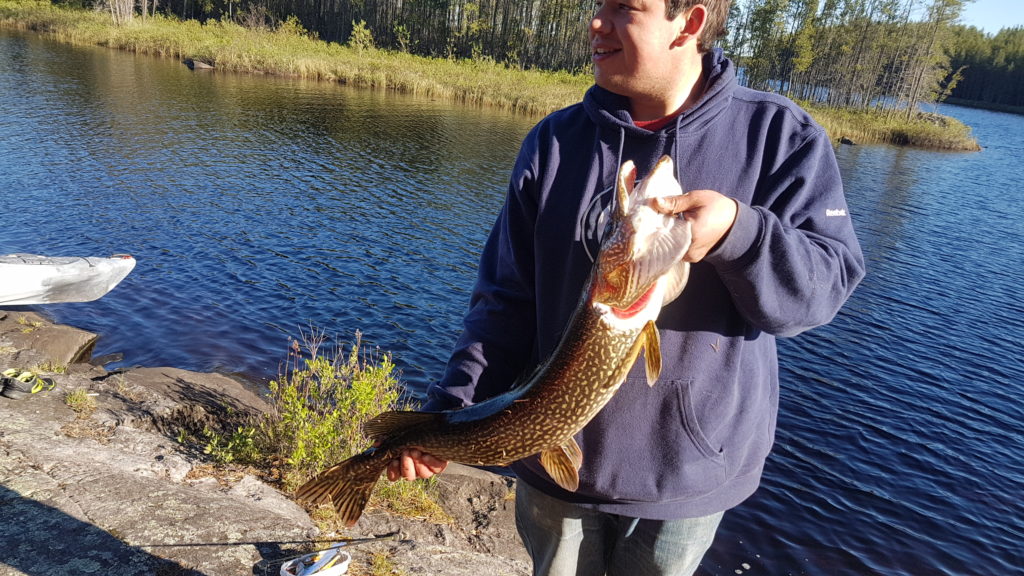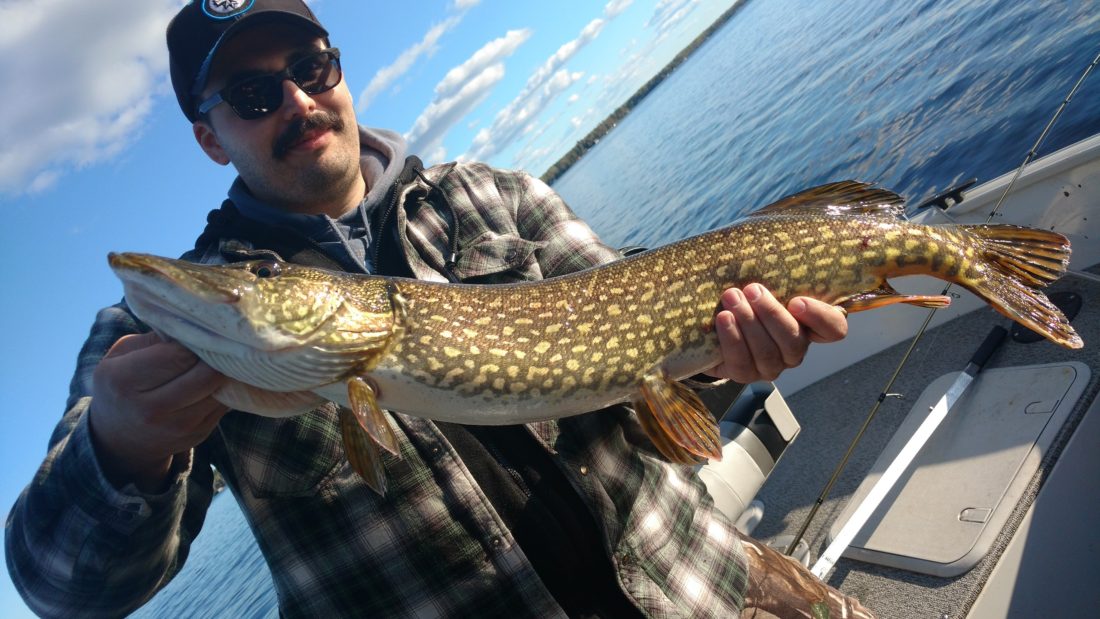So you want to catch some big pike, do you? Spring time is certainly the right time to try. Spring pike fishing is some of the best of the year, and that’s saying something for a fish as reliable to catch year round as the pike. There is no better time than Spring to catch trophy sized fish of all species. Pike in particular, with their early spawn and voracious appetites, offer the opportunity for some truly memorable experiences.

Spring Pike Spawn Timing
The first thing to know about fishing for any species in the spring is what the spawning patterns are. When it comes to pike, they are early spawners, sometimes even finishing before the ice has thawed. Pike eggs are sticky, and cling to plants, sticks, and other vegetative debris. They will lay these egg clusters primarily in shallow waters. In particular they will relate to highly oxygenated water coming in from creeks, rivers, and other sources of fresh water feeding into the lake. Pay attention to any areas where snow melt collects and runs into a lake during the thaw, and you will likely find a pike spawning ground.
Immediately after laying eggs in these shallow waters, pike will move slightly deeper to recover. During this recovery period they will stay in warm water. Look for water from 17-20°C, that is where the big females will typically be lounging from this point forward. As the spring wears on towards summer, this thermal band of water is what you want to follow to keep on top of them. As they recover in the warmer water they will go into a feeding mode. The further into spring you get, the more aggressively they will be feeding as they work to recover their energy stores, until finally during the heat of summer they go deep. At this point they revert to more normal, opportunistic feeding patterns.

You Know When, How About Where?
Where you set up for Spring pike fishing will depend on the time you get out, relative to ice-out. Due to how shallow everything is at and immediately after ice-out, there are many opportunities for shore fishing. This is a boon to those without a boat, who will not find any better time to catch monsters off shore at any other point in the year. Trophy pike will be in a couple feet of water, basking in the sun and recovering from the spawning efforts.
During the earliest spring, look for the waters that warm up fastest. This will be in northern bays and along northern shorelines of a lake. Much like a south facing window in your house is desirable for the amount of sunlight it will receive, these northern bays with openings facing south will be the first to reap the rewards of the spring sun. As such, they will be the first areas to welcome big, spawning pike.

Details Matter
Likewise, pay attention to what type of bottom the bay has. Darker colored bottoms -such as mud or dark granite- will absorb more light and heat up faster, compared to bright colors like sand or limestone. Shallow creeks and rivers will heat up faster, and dump that warmer water into the lake.
Neil, TNW contributor, favors fishing from shore and casting into the current of a small local falls. The water absorbs a lot of oxygen as it falls through the air, making the calmer back eddies and shorelines downstream prime spawning grounds.
” I have caught a surprising amount of pike while shore fishing with a #4 Mepps on a leader. The dyke near Silver Falls is always a hot spot. “

Knowing the above, it should be clear that in early spring you want to set up in these shallow warmer areas. As we get closer to summer and the water heats up more uniformly, the pike will move progressively deeper. During this late spring time, you will find that band of 17-20°C water further out. Look at the ends of creek channels, mouths of wide bays, and large weed flats on a downward slope.
Lures, What to Throw Early
When it comes to Spring pike fishing, lure choice can certainly affect your chances. Immediately after they have spawned, while they are still shallow in 1-3′ of water, you will want to take a more subtle approach. They are recovering from the effort, and are not looking to work for a meal right now. Small baits, with subdued, fluttering actions are best right now.
I recommend something like the Fusion Extreme from Lucky Bug Lures. It’s small enough not to spook weakened fish, has a shallow dive depth to weave in and around the spawning grounds, and a nice tight shimmy action that’s not too aggressive or flashy. You can pause it to let it sink, often triggering lazy hits as it nears the bottom.
Rylee, TNW Outdoors Person of the Month, totally nailed it when she said
” As for tips, I’d say don’t be afraid to use small presentations. Don’t get stuck on using large bait all the time. I caught that big pike on a tiny hair jig. Have also caught big pike on small spinner baits with leeches trolling for walleye.”

Lures, Moving into Late Spring
As the water warms up, Spring pike fishing gets really interesting. I often say that “you can catch a pike on an old shoe if you try”, and when I do, this is the time of year I am thinking of. Pike at this point have recovered from spawning and are looking to feed on anything and everything to recover their energy stores.
While they are aggressive this time of year and you can quite literally get them to bite on anything… If you want consistent hook ups, the challenge becomes separating your lure from the rest of the bait fish schools swimming around the same area. At this point, pike have come out of their post-spawn lethargy and are willing to put some effort into a bigger meal.
To this end, you should be throwing bigger lures, with more aggressive colors and actions. My personal favorite are spoons and variations of spoons. The Pike Attack from Molldem Canada is a great example of a spoon variant that I would throw. The corkscrew twisting action on a fast retrieve is sure to stand out and get attention amidst the rest of the baitfish.
Rattling baits are another method to get attention, as Colin, TNW contributor knows well.
“My favorite lure for catching late Spring pike is a rattling Rapala lipless crank. The commotion it causes under water seems to always attract them. If I’m ever in danger of being skunked, I throw a rattler on”

Final Thoughts on Spring Pike
I think it’s fairly obvious, but I love Spring pike fishing. It’s a great time of year to catch some real trophy sized fish. Best of all, it’s accessible to boaters and shore fishers alike. What better way to introduce someone new to the sport than standing on a sunny bank and pulling in one of these toothy beasts?







[…] of great tasting fish. Of course, like many other species, this is because of the spawn. Similar to pike, walleye spawn in shallow water and move out deeper as spring turns into summer. If you know where […]